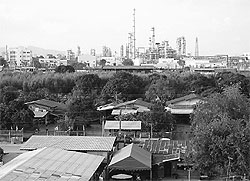
Many news stories about the Map Ta Phut industrial estate issue focus on the latest developments — court decisions, the number of suspended cases, latest appeals, etc.
An opinion piece in yesterday’s Bangkok Post is worth pointing out, however, because it provides some analysis and takes a big picture look at the situation.
The piece, written by two Political Science academics — one from the U.S.’s Northern Illinois University and one from Thailand’s Thammasat University — is called “Map Ta Phut spat hides a colossal failure.”
Here are a few relevant snippets, though I suggest reading the piece in full.
One lesson that emerges from this chronology of events is that Thais have long recognised the need for wider public participation in public policy making, in large part reflecting sensitivity to the environmental consequences of large energy, industrial and infrastructural projects.
Despite this understanding, however, Thais have to date not been successful in devising mechanisms to balance the voices of the diverse interests involved and to then (and this is crucial) reach an authoritative decision that will be accepted as at least procedurally legitimate and, contingently, the last word by most of those interests. This failure is now evident in the impasse that has been reached in Map Ta Phut.
And:
The difficulty involved in the Map Ta Phut conflicts goes well beyond a refusal to confront environmental issues. Several business voices have suggested, in fact, that they worry less about more stringent environmental regulations than about a lack of regulatory clarity. The absence of effective, inclusive deliberations that result in widely supported public policies that state officials implement authoritatively is evident in other areas of Thai public life as well. Indeed, the planning processes governing Thailand’s major public investment projects such as airports, mass transit, irrigation, and even the ports and industrial estates of the Eastern Seaboard projects (where Map Ta Phut is located) themselves often have been uncertain, slow and episodic. Or consider that after many years and studies, decisions and revisions, Thailand’s parliament has yet to relocate.
Making decisions about big, expensive and complex projects with environmental impacts is of course a challenge in any country and often leads to delays, challenges, and cost overruns. The problem, however, seems to be acute in Thailand.
Why is it so difficult to make big, consequential decisions in Thailand? In part, the answer relates to Thailand’s political pluralism that impedes the sort of streamlined and technocratic decision procedures we might find in China or Singapore. Even under Thailand’s authoritarian regimes of the past 30 years, political power typically has not been concentrated enough to make it easy to reach big decisions and make them stick. (The Thai Rak Thai Party’s political dominance from 2001 to 2006 and then prime minister Thaksin Shinawatra’s decisive personality marked a major exception to these patterns.)
And:
Weak political institution
Still other factors that may make it difficult to reach big decisions in Thailand relate to the feebleness of the country’s political institutions. While in many countries it seems natural to accord major influence over key public policies to formal representative institutions – legislatures and political parties – in Thailand many people are dubious of the representative character of those institutions. As a result, Thais are as apt to view decisions reached in parliament as fixes bargained among an oligopoly of special interests as they are to see it as a reasoned compromise growing out of relatively disinterested and sober deliberations.
(Emphasis mine.)
Again, I suggest reading the piece in full.
As a reminder, here is my Jan. 15 post with PM Abhisit’s remarks on Map Ta Phut.
I’m also establishing a Map Ta Phut tag for future posts on the issue.
Image source: Bangkok Post.









































